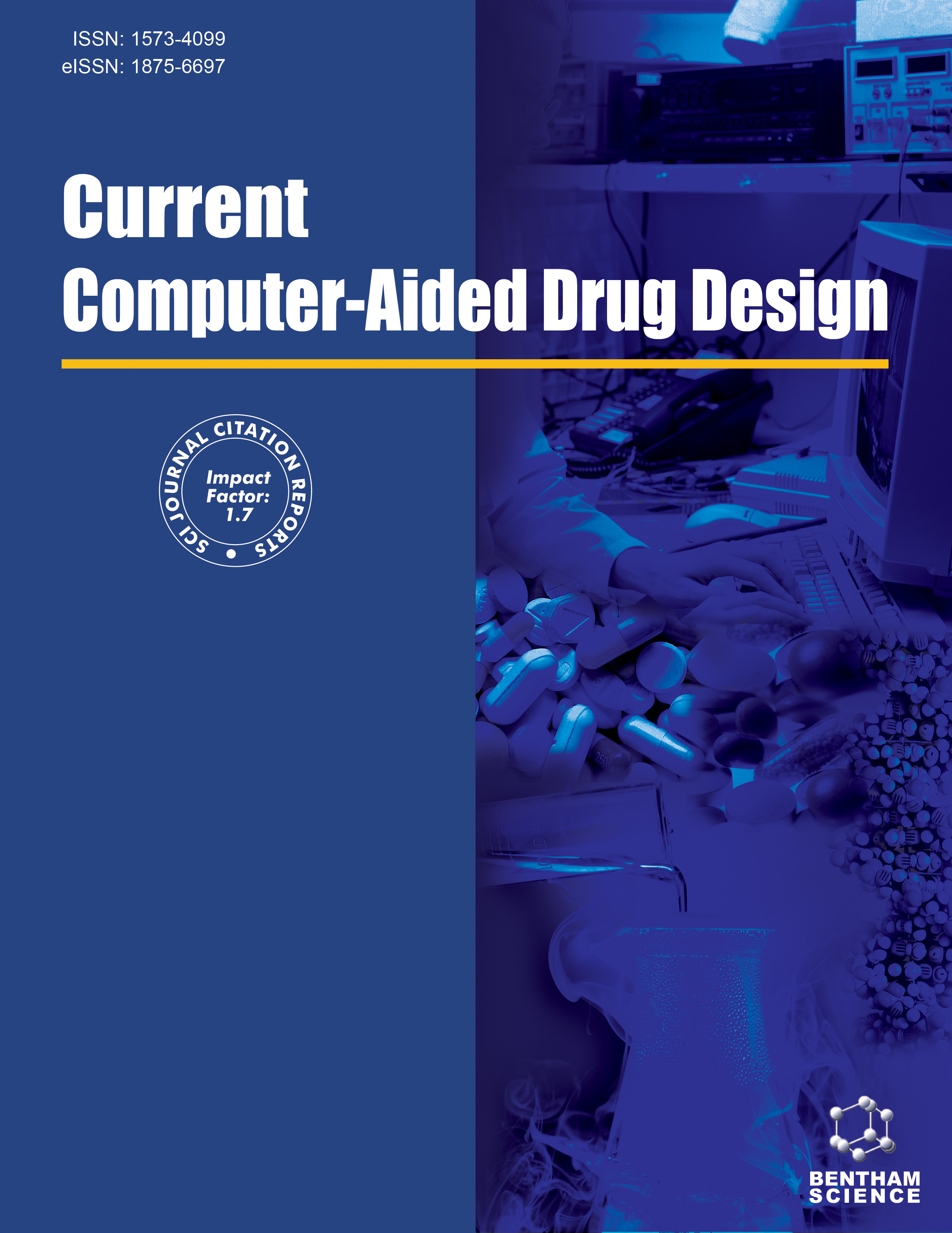- Home
- A-Z Publications
- Current Computer - Aided Drug Design
- Previous Issues
- Volume 21, Issue 1, 2025
Current Computer - Aided Drug Design - Volume 21, Issue 1, 2025
Volume 21, Issue 1, 2025
-
-
Computer-aided Drug Discovery Approaches in the Identification of Anticancer Drugs from Natural Products: A Review
More LessNatural plant sources are essential in the development of several anticancer drugs, such as vincristine, vinblastine, vinorelbine, docetaxel, paclitaxel, camptothecin, etoposide, and teniposide. However, various chemotherapies fail due to adverse reactions, drug resistance, and target specificity. Researchers are now focusing on developing drugs that use natural compounds to overcome these issues. These drugs can a Read More
-
-
-
Detection of Brain Tumor Employing Residual Network-based Optimized Deep Learning
More LessAuthors: Saransh Rohilla and Shruti JainBackgroundDiagnosis and treatment planning play a very vital role in improving the survival of oncological patients. However, there is high variability in the shape, size, and structure of the tumor, making automatic segmentation difficult. The automatic and accurate detection and segmentation methods for brain tumors are proposed in this paper.MethodsA modified ResNet50 model was used for tumor detection, a Read More
-
-
-
DeepTransformer: Node Classification Research of a Deep Graph Network on an Osteoporosis Graph based on GraphTransformer
More LessAuthors: Yixin Liu, Guowei Jiang, Miaomiao Sun, Ziyan Zhou, Pengchen Liang and Qing ChangBackgroundOsteoporosis (OP) is one of the most common diseases in the elderly population. It is mostly treated with medication, but drug research and development have the disadvantage of taking a long time and having a high cost.ObjectiveTherefore, we developed a graph neural network with the help of artificial intelligence to provide new ideas for drug research and development for OP.MethodsIn this study, we built a ne Read More
-
-
-
Discovery of Novel Pyrimidine Based Small Molecule Inhibitors as VEGFR-2 Inhibitors: Design, Synthesis, and Anti-cancer Studies
More LessAuthors: Sachin A. Dhawale, Santosh N. Mokale and Pratap S. DabhadeBackgroundReceptor tyrosine kinases (RTKs) are potent oncoproteins in cancer that, when mutated or overexpressed, can cause uncontrolled growth of cells, angiogenesis, and metastasis, making them significant targets for cancer treatment. Vascular endothelial growth factor receptor 2 (VEGFR2), is a tyrosine kinase receptor that is produced in endothelial cells and is the most crucial regulator of angiogenic factors involv Read More
-
-
-
Insights into the Molecular Mechanisms of Bushen Huoxue Decoction in Breast Cancer via Network Pharmacology and In vitro experiments
More LessAuthors: Hongyi Liang, Guoliang Yin, Guangxi Shi, Xiaofei Liu, Zhiyong Liu and Jingwei LiAimsBreast cancer (BC) is by far seen as the most common malignancy globally, with 2.261 million patients newly diagnosed, accounting for 11.7% of all cancer patients, according to the Global Cancer Statistics Report (2020). The luminal A subtype accounts for at least half of all BC diagnoses. According to TCM theory, Bushen Huoxue Decoction (BSHXD) is a prescription used for cancer treatment that may influence luminal A s Read More
-
-
-
Insights to Design New Drugs against Human African Trypanosomiasis Targeting Rhodesain using Covalent Docking, Molecular Dynamics Simulations, and MM-PBSA Calculations
More LessBackgroundNeglected tropical diseases (NTDs) are parasitic and bacterial diseases that affect approximately 149 countries, mainly the poor population without basic sanitation. Among these, Human African Trypanosomiasis (HAT), known as sleeping sickness, shows alarming data, with treatment based on suramin and pentamidine in the initial phase and melarsoprol and eflornithine in the chronic phase. Thus, to discove Read More
-
-
-
Exploring the Mechanisms of Sanguinarine in the Treatment of Osteoporosis by Integrating Network Pharmacology Analysis and Deep Learning Technology
More LessAuthors: Yonghong Tang, Daoqing Zhou, Fengping Gan, Zhicheng Yao and Yuqing ZengBackgroundSanguinarine (SAN) has been reported to have antioxidant, anti-inflammatory, and antimicrobial activities with potential for the treatment of osteoporosis (OP).ObjectiveThis work purposed to unravel the molecular mechanisms of SAN in the treatment of OP.MethodsOP-related genes and SAN-related targets were predicted from public databases. Differential expression analysis and VennDiagram were ad Read More
-
-
-
Comprehensive In Silico Analysis of Uncaria Tomentosa Extract: Chemical Profiling, Antioxidant Assessment, and CLASP Protein Interaction for Drug Design in Neurodegenerative Diseases
More LessAuthors: Sanjesh Kumar and Siva Prasad PandaBackgroundUncaria tomentosa is a traditional medicinal herb renowned for its anti-inflammatory, antioxidant, and immune-enhancing properties. In the realm of neurodegenerative diseases (NDDS), CLASP proteins, responsible for regulating microtubule dynamics in neurons, have emerged as critical players. Dysregulation of CLASP proteins is associated with NDDS, such as Alzheimer's, Parkinson's, and Huntington's diseases. C Read More
-
-
-
Prescription Data Mining and Network Pharmacology Study of 1152 Patients with Rectal Prolapse using Traditional Chinese Medicine
More LessAuthors: Meng Zhang, Shao-liangTang, Tong-lingYang, Yan Cheng and Yue GongBackgroundIn recent years, the incidence of rectal prolapse has increased significantly due to the sedentary lifestyle and irregular eating habits of modern life. However, there is a lack of clinical studies on the treatment of rectal prolapse with traditional Chinese medicine (TCM) with a large sample size. Therefore, this study investigated the characteristics of rectal prolapse treatment formulas and then studied the network p Read More
-
Volumes & issues
-
Volume 21 (2025)
-
Volume 20 (2024)
-
Volume 19 (2023)
-
Volume 18 (2022)
-
Volume 17 (2021)
-
Volume 16 (2020)
-
Volume 15 (2019)
-
Volume 14 (2018)
-
Volume 13 (2017)
-
Volume 12 (2016)
-
Volume 11 (2015)
-
Volume 10 (2014)
-
Volume 9 (2013)
-
Volume 8 (2012)
-
Volume 7 (2011)
-
Volume 6 (2010)
-
Volume 5 (2009)
-
Volume 4 (2008)
-
Volume 3 (2007)
-
Volume 2 (2006)
-
Volume 1 (2005)
Most Read This Month
Article
content/journals/cad
Journal
10
5
false
en


